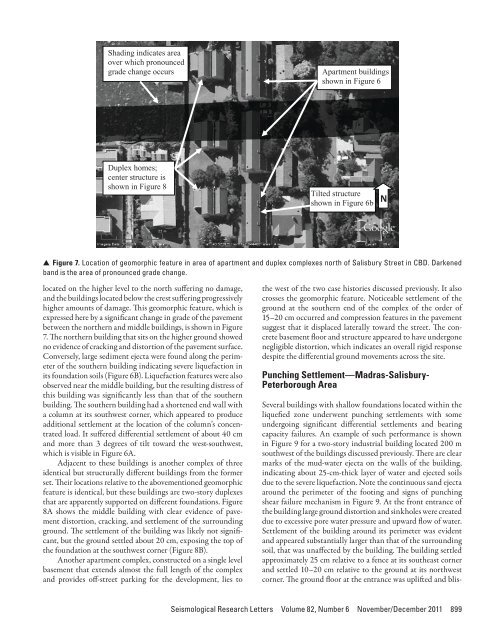Here - Stuff
Here - Stuff
Here - Stuff
You also want an ePaper? Increase the reach of your titles
YUMPU automatically turns print PDFs into web optimized ePapers that Google loves.
Shading indicates areaover which pronouncedgrade change occursApartment buildingsshown in Figure 6Duplex homes;center structure isshown in Figure 8Tilted structureshown in Figure 6bN▲ ▲ Figure 7. Location of geomorphic feature in area of apartment and duplex complexes north of Salisbury Street in CBD. Darkenedband is the area of pronounced grade change.located on the higher level to the north suffering no damage,and the buildings located below the crest suffering progressivelyhigher amounts of damage. This geomorphic feature, which isexpressed here by a significant change in grade of the pavementbetween the northern and middle buildings, is shown in Figure7. The northern building that sits on the higher ground showedno evidence of cracking and distortion of the pavement surface.Conversely, large sediment ejecta were found along the perimeterof the southern building indicating severe liquefaction inits foundation soils (Figure 6B). Liquefaction features were alsoobserved near the middle building, but the resulting distress ofthis building was significantly less than that of the southernbuilding. The southern building had a shortened end wall witha column at its southwest corner, which appeared to produceadditional settlement at the location of the column’s concentratedload. It suffered differential settlement of about 40 cmand more than 3 degrees of tilt toward the west-southwest,which is visible in Figure 6A.Adjacent to these buildings is another complex of threeidentical but structurally different buildings from the formerset. Their locations relative to the abovementioned geomorphicfeature is identical, but these buildings are two-story duplexesthat are apparently supported on different foundations. Figure8A shows the middle building with clear evidence of pavementdistortion, cracking, and settlement of the surroundingground. The settlement of the building was likely not significant,but the ground settled about 20 cm, exposing the top ofthe foundation at the southwest corner (Figure 8B).Another apartment complex, constructed on a single levelbasement that extends almost the full length of the complexand provides off-street parking for the development, lies tothe west of the two case histories discussed previously. It alsocrosses the geomorphic feature. Noticeable settlement of theground at the southern end of the complex of the order of15–20 cm occurred and compression features in the pavementsuggest that it displaced laterally toward the street. The concretebasement floor and structure appeared to have undergonenegligible distortion, which indicates an overall rigid responsedespite the differential ground movements across the site.Punching Settlement—Madras-Salisbury-Peterborough AreaSeveral buildings with shallow foundations located within theliquefied zone underwent punching settlements with someundergoing significant differential settlements and bearingcapacity failures. An example of such performance is shownin Figure 9 for a two-story industrial building located 200 msouthwest of the buildings discussed previously. There are clearmarks of the mud-water ejecta on the walls of the building,indicating about 25-cm-thick layer of water and ejected soilsdue to the severe liquefaction. Note the continuous sand ejectaaround the perimeter of the footing and signs of punchingshear failure mechanism in Figure 9. At the front entrance ofthe building large ground distortion and sinkholes were createddue to excessive pore water pressure and upward flow of water.Settlement of the building around its perimeter was evidentand appeared substantially larger than that of the surroundingsoil, that was unaffected by the building. The building settledapproximately 25 cm relative to a fence at its southeast cornerand settled 10–20 cm relative to the ground at its northwestcorner. The ground floor at the entrance was uplifted and blis-Seismological Research Letters Volume 82, Number 6 November/December 2011 899
















